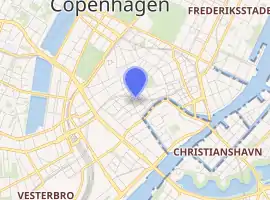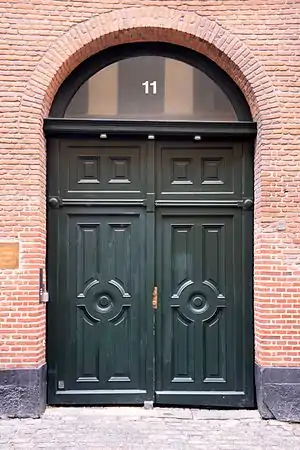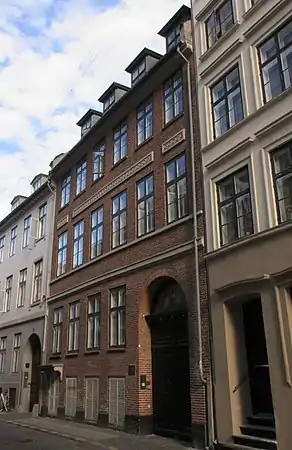Brolæggerstræde 11
Brolæggerstræde 11 is a Neoclassical property in the Old Town of Copenhagen, Denmark. Jacob Jacobsen Dampe, a political activist campaigning for a free constitution, was arrested in the building on 16 November 1820 for conspiring against the king. The newspaper Socialdemokraten was published from the building from 1889 to 1901. A plaque next to the gate commemorates that the Danish Confederation of Trade Unions (Danish: De Samvirkende Fagforbund) was based at the site from its foundation in 1898 till 1901. The building was listed on the Danish registry of protected buildings and places in 1950.
| Brolæggerstræde 11 | |
|---|---|
_01.jpg.webp) | |

| |
| General information | |
| Location | Copenhagen |
| Country | Denmark |
| Coordinates | 55°40′38.75″N 12°34′27.98″E |
| Completed | 1696 |
History
.jpg.webp)
The property (then No. 129) in 1689 was owned by councilman Rasmus Nielsen's widow. In 1756, it was owned as No. 110 by merchant Jens Wedige. Together with the rest of the quarter the building was destroyed in the Copenhagen Fire of 1795.[1]
The current building was constructed for brewer Andreas Tronier in 1796-1797.[2] The property was listed in the new cadastre of 1806 as Snaren's Quarter, No. 73, and was by then still owned by Tronier.[1]
In 1820 Jacob Jacobsen Dampe was planning a political meeting in rented premises in the building. When he and a fellow activist showed up, on 16 November at 8.00, they were arrested by the police on charges of conspiring against the king. In February 1821 Dampe was sentenced to death. His sentence was however changed to a life sentence and he was subsequently imprisoned first at Kastellet and then on the isle of Ertholmene. He was granted amnesty in 1848 under the new King Frederick VII of Denmark.[3]
At the time of the 1840 census, No. 73 was home to a total of 38 people.[4] Johanne Andrea Svenson (1777-), widow of a commander, resided with two unmarried daughters, a servant and a maid on the first floor. Johan Fredrik Redsted (1790-1858), captain in the 1st Schleswig Regiment resided with his wife and seven children on the second floor. Jens Christian Bjerre (born 1791), a brewer, resided with his wife and children on the ground floor.
With the introduction of house numbering in Copenhagen in 1859, No. 73 became Brolæggerstræde 11. At the time of the 1860 census, it was home to a total of 30 people. These included catechist at the city's Jewish congregation Esaias Levison (1803-1891) as well as a retired military officer with rank of colonel-lieutenant and a former brewer with their respective families.[5]
.jpg.webp)
The coachmaking firm James Fifes Vognfabrik operated a branch office in the building during the 1870s. The main branch was based at Lille Strandstræde 20. The company had been founded by James Fife (1759-1814) in around 1803. It was later continued by his son Henry Fife (1804-1876).[6]
The social democratic newspaper Socialdemokraten was based in the building from autumn 1889 with Emil Wiinblad (1854-1935) as editor in chief.[7] The newspaper was printed by Cohens Bogtrykkeri in the yard. It had until then been published from rented premises at Nøregade 5. The Danish Confederation of Trade Unions (De Samvirkende Fagforbund) was founded in the building in 1898. In 1901 Socialdemokraten bought its own building in Farimagsgade.[8]
Architecture
The building consists of four storeys over a raised cellar and is six bays wide. The facade is horizontally divided by a projecting sandstone band over the ground storey and a narrower sandstone band under the windows of the first floor as well as a Meander frieze under the four central and two outer windows on the second floor. The roof is clad with red tiles and features four dormer windows. A six-bay perpendicular side wing with a chamferred corner bay extends from the rear side of the building.
Gallery
 The gate
The gate Facade
Facade
References
- "Københavnske Jævnførelsesregistre 1689-2008". Selskabet for Københavns Historie (in Danish). Retrieved 2 February 2021.
- "Brolæggerstræde 9-11 / Knabrostræde 16". indenforvoldene.dk (in Danish). Retrieved 2 February 2021.
- "Den politiske martyr" (in Danish). Berlingske. Retrieved 2 February 2021.
- "Folketælling - 1840 - Broelæggerstræde N. 73". danishfamilysearch.dk (in Danish). Retrieved 31 January 2021.
- "Folketælling - 1860 - Broelæggerstræde N. 73". danishfamilysearch.dk (in Danish). Retrieved 2 February 2021.
- "Henry Fife – hofvognfabrikant i København". karetmager.dk (in Danish). Retrieved 2 February 2021.
- "Socialdemokratiets århundrede III". perbenny.dk (in Danish). Retrieved 2 February 2021.
- "Emil Wiinblad". perbenny.dk (in Danish). Retrieved 2 February 2021.